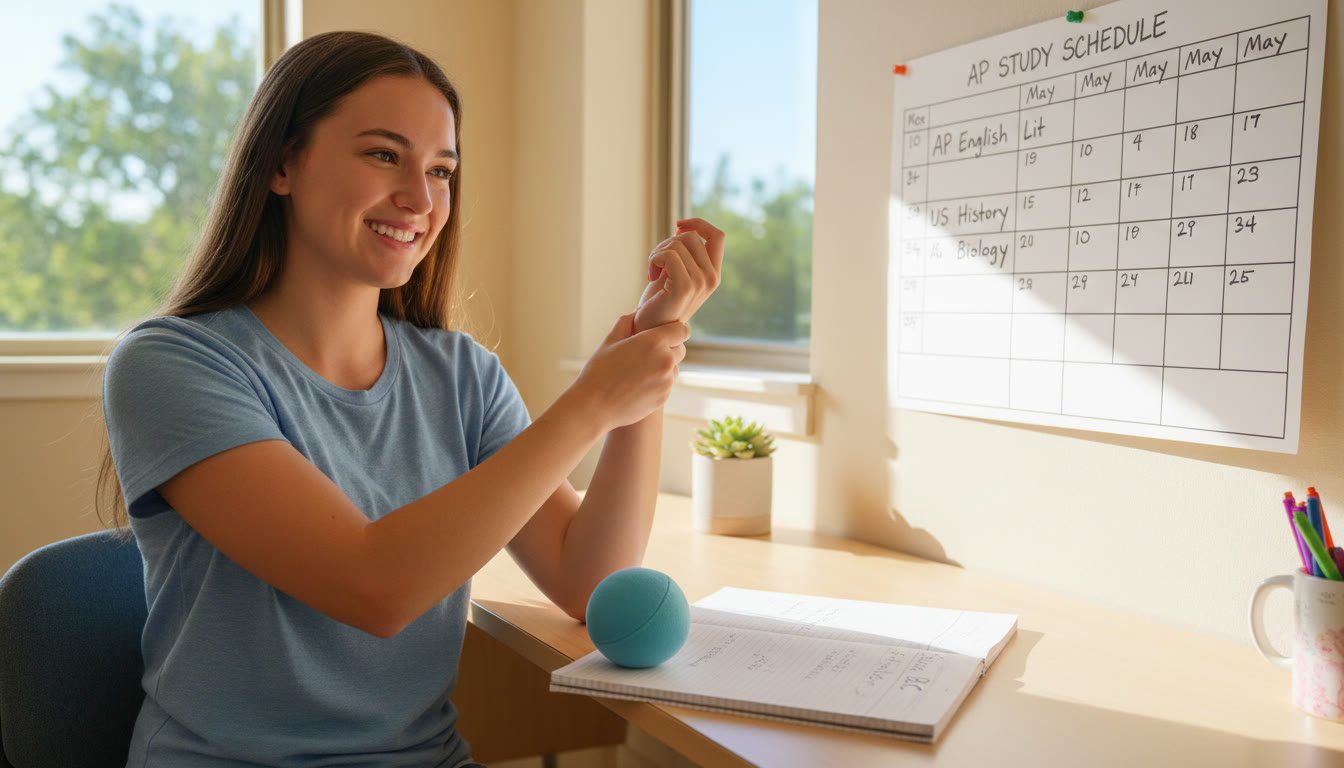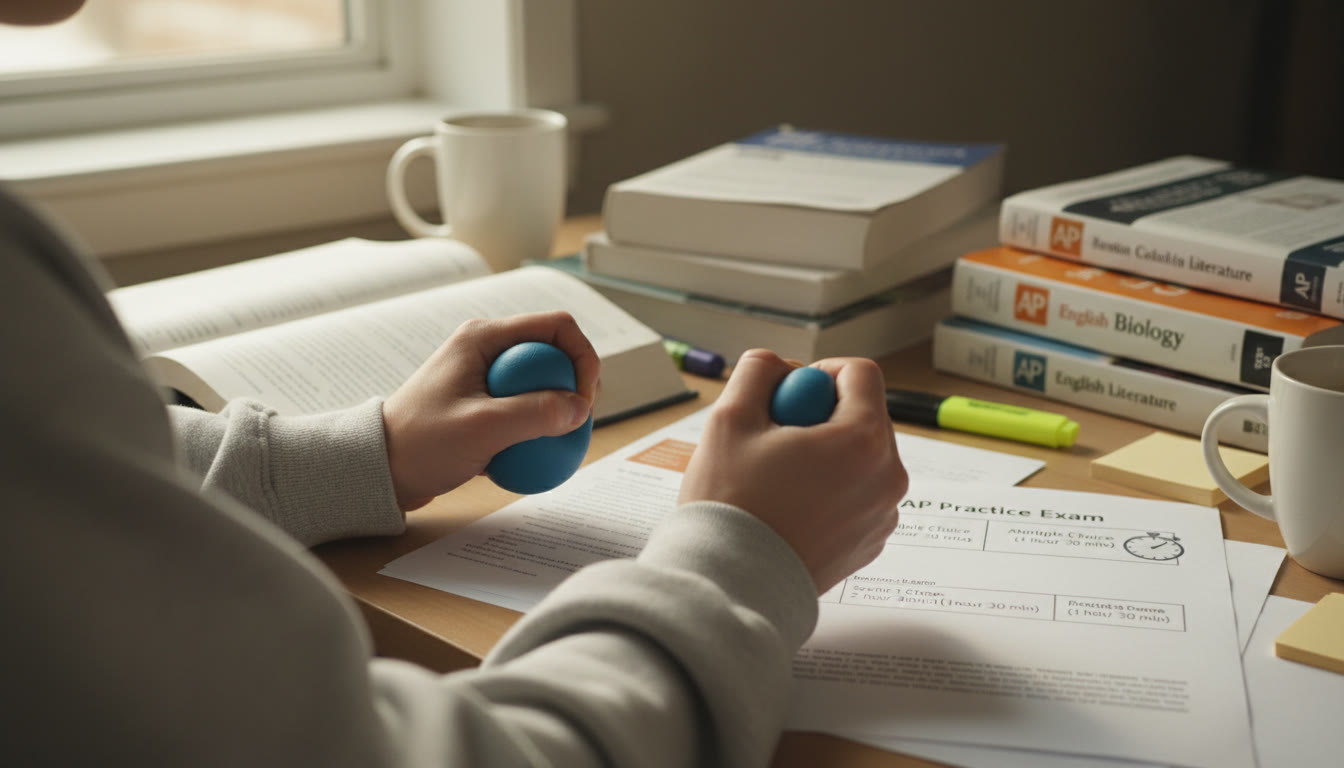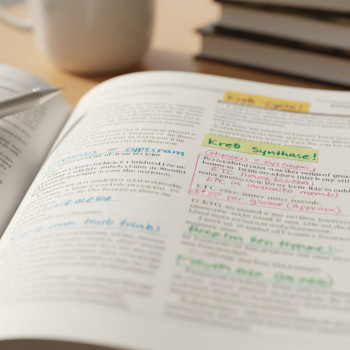Why Hand Cramps and Fatigue Matter for AP Students
If you’ve ever been midway through a long free-response section and felt your hand seize up, or noticed your notes turn into an indecipherable scrawl after two hours of studying, you’re not alone. AP exams ask you to perform at a high level for extended periods — writing essays, annotating passages, sketching graphs, or solving multi-step problems. All of that sustained manual work can lead to hand cramps, muscle fatigue, and a creeping sense of panic when your hand just won’t cooperate.
This post is a friendly, practical guide written especially for AP students: how to prevent discomfort, how to set up study sessions that protect your hands, and what to do when cramps strike during a practice test or the real exam. We’ll mix physiology, ergonomics, quick routines, and realistic tips that fit an AP student’s schedule. And where it fits naturally, you’ll see how Sparkl’s personalized tutoring and tailored study plans can help balance focused practice with healthy, sustainable habits.
Understanding the Basics: What Causes Hand Cramps and Fatigue?
Before we jump into solutions, it helps to know what’s happening. Hand cramps and fatigue typically arise from a combination of:
- Muscle overuse: Repeated movements like writing, highlighting, or drawing without adequate breaks.
- Poor posture and ergonomics: Wrist angle, chair height, and desk setup influence how hard your hand and forearm muscles must work.
- Grip tension: Holding a pen or pencil too tightly increases muscular load and reduces blood flow to small muscles in the hand.
- Insufficient warm-up or recovery: Jumping straight into long writing sessions without gentle movement or stretching.
- Fatigue from overall stress and poor sleep: Tired bodies don’t tolerate repetitive tasks as well.
Think of your hand like any other athlete’s muscle group — it needs warm-ups, smart training, rest days, and the right gear.
How AP Exam Conditions Make It Tougher
AP testing environments can amplify problems. Whether you’re working digitally on an exam app or writing long essays on paper, you often face:
- Extended continuous writing or problem solving without frequent natural micro-breaks.
- Pressure to write quickly — which encourages tight grips and hunched shoulders.
- Unfamiliar seating and desk surfaces during tests that may force awkward wrist positions.
Preparation is more than mastering content — it’s conditioning your body to perform under the same physical demands as the exam.
Daily Preventative Routine: 15–20 Minutes That Saves Pain
Make these small routines part of your daily AP prep — five days a week is plenty to see noticeable benefits. Each step is short and easy to do between study blocks.
- Warm-up (3 minutes): Shake your hands gently, flex and extend fingers, rotate wrists clockwise and counterclockwise. This increases circulation and primes muscles.
- Stretch set (5 minutes):
- Wrist flexor stretch: With your arm straight, gently pull fingers back toward you with the opposite hand for 20–30 seconds.
- Wrist extensor stretch: Arm straight, palm down, gently push the fingers toward you for 20–30 seconds.
- Finger spreads: Press fingers together then spread wide, repeat 8–10 times.
- Strength and coordination (5 minutes):
- Squeezing a soft ball or therapy putty for 10–15 reps per hand helps endurance for long writing sections.
- Thumb opposition: touch thumb to each fingertip slowly and deliberately 2–3 times per finger.
- Mobility reset (2–5 minutes): Roll shoulders back, tuck and release chin for a neck reset, and take deep diaphragmatic breaths to reset tension.
Why this routine works
Warm-ups increase blood flow. Gentle stretches lengthen overworked tendons and reduce compression in narrow spaces like the carpal tunnel. Strength exercises boost endurance so your hand doesn’t fatigue as quickly. The mobility and breathing pieces address the common problem of global tension locking into your hands.

Ergonomics 101: Small Adjustments, Big Difference
AP students often study in borrowed spots — library tables, classroom desks, car seats. Even so, a few quick adjustments help:
- Desk height: Your forearms should be roughly parallel to the floor when writing. If your desk is too high, you’ll lift your shoulders; if too low, you’ll hunch.
- Chair support: Sit with a slight curve in your lower back. Use a cushion if necessary to raise your hips above your knees slightly — this helps shoulder alignment.
- Wrist position: Keep wrists in neutral (not strongly flexed or extended). Slightly rotate your paper or keyboard so your wrist can remain straight.
- Pen grip: Hold loosely. Aim to let the pen rest between your fingers with minimal pressure — think “guide” more than “clamp.”
- Lighting: Adequate lighting prevents leaning forward and tensing shoulders.
Invest in an inexpensive ergonomic pen or pencil if you consistently feel pain — a wider, cushioned grip reduces the need to squeeze.
Study Sessions That Protect Your Hands
How you structure study time matters as much as the stretches you do. Here are realistic session templates for busy students.
Pomodoro Plus (50 minutes focused, 10 minutes recovery)
- Break the session into two 25-minute blocks of concentrated study with a 5-minute micro-break between them. Use the final 10 minutes for active recovery: wrist stretches, gentle hand exercises, and walking.
- This gives your writing muscles a planned rest without sacrificing study quality.
Mock Exam Routine
- Before your full-length practice exam: 5–10 minute warm-up stretches and a light squeeze ball routine.
- During the practice, mark mini-break cues on the timing sheet — a 30-second shake-and-stretch at each hour marker if allowed by test format during practice.
- After the practice: 10 minutes dedicated to mobility — forearm stretches, shoulder rolls, wrist rotations.
Quick Fixes When a Cramp Hits
During a mock exam or a practice test, cramps can surprise you. Use these calm, effective moves:
- Stop writing immediately and shake the hand down at your side for 10–20 seconds to encourage blood flow.
- Gently stretch the cramped muscles by extending fingers and flexing the wrist — hold for 15–30 seconds.
- Massage the palm and forearm with the opposite hand, following the muscle line from wrist to elbow.
- If possible, swap tasks temporarily (e.g., read a question aloud silently or outline with your non-dominant hand) to let the dominant hand rest for a minute or two.
Crucially: stay calm. Panic increases tension and can make cramps worse.
Weekly Conditioning Plan for Exam Season
AP seasons are intense; an easy weekly plan keeps your hands resilient and your body recovered.
| Day | Focus | Time | Key Activities |
|---|---|---|---|
| Monday | Warm-up + Strength | 15–20 min | Full routine: stretches, therapy ball work, thumb opposition |
| Tuesday | Study Session Practice | 50–60 min | Pomodoro Plus; practice handwriting speed and legibility |
| Wednesday | Mobility + Rest | 10–15 min | Light stretches, shoulder and neck mobility, breathing exercises |
| Thursday | Endurance | 30–40 min | Longer mixed practice: timed FRQs with mini-break cues |
| Friday | Simulated Conditions | Full practice test | Full-length practice; pre- and post-session routine |
| Saturday | Active Recovery | 15 min | Stretching, light cardio, hydration focus |
| Sunday | Review + Reset | 10–20 min | Reflect, plan next week’s sessions; gentle hand care |
Tools and Gear That Help (But Don’t Replace Good Habits)
Gear can make a difference, but it’s most effective when paired with the routines above.
- Ergonomic pens or fountain pens with wider barrels — reduce force needed to write.
- Soft therapy balls or putty — for grip strength and endurance training.
- Wrist rests or small cushions — use when typing or doing long note-taking sessions.
- Portable timer or phone app — schedule micro-breaks during study blocks.
Remember: if a device causes you to contort your wrist or lean forward, stop using it. Comfort and natural posture win over novelty.
Nutrition, Hydration, and Sleep: The Often-Missed Trio
Your muscles need fuel and rest. Don’t underestimate the role of basic self-care in preventing cramps:
- Hydration: Even mild dehydration increases the risk of muscle cramps. Keep a water bottle nearby during study sessions and exams where allowed.
- Electrolytes: Balanced diets with potassium, magnesium, and calcium help muscle function. Bananas, leafy greens, nuts, and dairy or fortified alternatives are good choices.
- Sleep: Muscle recovery largely happens during deep sleep. Aim for 7–9 hours during heavy study phases.
Mental Strategies: Tension Management During Tests
Stress tightens muscles. Use these quick mental resets during practice tests or the exam:
- Box breathing: inhale 4, hold 4, exhale 4, hold 4 — one full cycle between questions recalibrates tension.
- Micro-visualization: before a timed writing section, picture your hand moving smoothly and your writing staying legible. This primes coordinated, relaxed movement.
- Task chunking: break large writing tasks into manageable parts — outline for two minutes, write for 12, then breathe and scan.
When to Seek Help: Persistent Pain or Numbness
If you experience ongoing numbness, tingling, or persistent sharp pain, it’s important to consult a medical professional or occupational therapist. These symptoms can indicate conditions that need specific treatment, such as nerve compression or tendon issues. Don’t ignore persistent signs — early guidance prevents longer interruptions to studying.
How Smart Tutoring Supports Healthy, Effective Prep
Academic coaching that treats practice and physical well-being as partners can be a game-changer. For AP students, Sparkl’s personalized tutoring blends 1-on-1 guidance, tailored study plans, and AI-driven insights to help you structure effective practice without overloading your body. Tutors who understand pacing can:
- Create study schedules that build endurance gradually and add recovery windows.
- Teach strategies for efficient handwriting and timed-response techniques to minimize unnecessary strain.
- Use data to spot when a student’s practice volume is rising too quickly and recommend adjustments.
When academic coaching accounts for both content mastery and physical resilience, students stay productive and pain-free through the busiest weeks.

Sample Exam-Day Checklist: Keep Your Hands Ready
On exam day, preparation should be simple and calming. Here’s a quick checklist to follow before you enter the room:
- Do a 3–5 minute warm-up: wrist rotations, finger stretches, and light squeezes — nothing strenuous.
- Pack an ergonomic pen or your preferred writing tool (if allowed) and a backup pen.
- Drink water beforehand, and avoid heavy caffeine that might increase jittery tension.
- Use the restroom and do a brief posture check: feet flat, shoulders relaxed, neutral wrist position.
- Have a quiet mental routine — three deep breaths and a quick positive cue (“Focus, steady, clear”) — then begin.
Real Student Examples: Small Changes, Big Wins
Case 1: Maya, AP English — Maya used to cramp halfway through timed essays. Switching to a wider grip pen, doing a five-minute warm-up before each practice test, and practicing outlines reduced her cramps dramatically. She gained both speed and legibility.
Case 2: Alex, AP Calculus — After long problem sets he’d get forearm fatigue. By adjusting desk height, adding 5-minute mobility breaks every 40 minutes, and using a soft ball for strength work twice a week, his endurance improved and he could tackle full practice exams with less pain.
These examples show how simple ergonomic and routine shifts can make content practice more effective and sustainable.
Putting It All Together: A Final Roadmap
Here’s a condensed action plan you can implement this week:
- Start each study session with a 2–3 minute warm-up and end with a 2–5 minute recovery stretch.
- Structure practice with forced micro-breaks (Pomodoro Plus) and mark them on timers.
- Check your ergonomic setup and experiment with pen grips that reduce squeeze force.
- Incorporate grip-strength work twice a week and mobility once or twice a week.
- Prioritize hydration, sleep, and balanced nutrition to support muscle function.
- Use targeted tutoring and study plans — like those offered through Sparkl — when you need pacing, personalized strategies, and data-driven tweaks to your prep plan.
Closing Thoughts
AP success is more than content mastery. It’s an interplay between knowledge, strategy, and the physical ability to perform under pressure. Hand cramps and fatigue are manageable — and preventable — with consistent warm-ups, smart ergonomics, scheduled recovery, and sensible conditioning. Treat your hands with the same respect you give your study schedule: a little daily care goes a long way.
Take a moment tonight to try one stretch, swap to a wider pen for tomorrow’s study block, or add a two-minute mobility reset between practice sections. Small moves now can mean smoother handwriting, clearer thinking, and more confidence when it counts.
Good luck with your AP prep — steady practice, smart rest, and compassionate pacing will carry you to the finish line.



















No Comments
Leave a comment Cancel